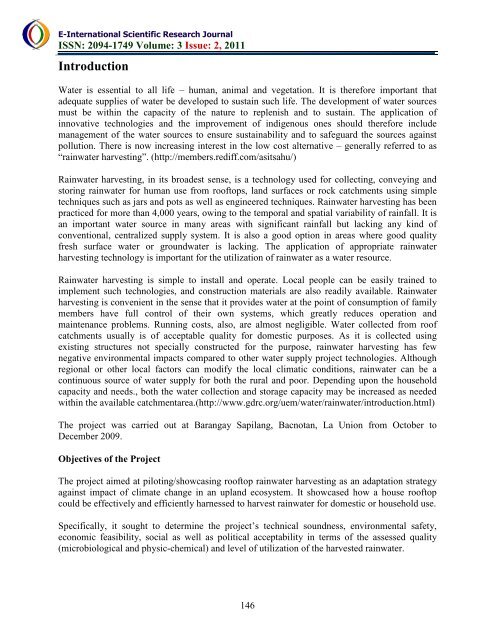download the full article here - E-International Scientific Research ...
download the full article here - E-International Scientific Research ...
download the full article here - E-International Scientific Research ...
Create successful ePaper yourself
Turn your PDF publications into a flip-book with our unique Google optimized e-Paper software.
E-<strong>International</strong> <strong>Scientific</strong> <strong>Research</strong> Journal<br />
ISSN: 2094-1749 Volume: 3 Issue: 2, 2011<br />
Introduction<br />
Water is essential to all life – human, animal and vegetation. It is <strong>the</strong>refore important that<br />
adequate supplies of water be developed to sustain such life. The development of water sources<br />
must be within <strong>the</strong> capacity of <strong>the</strong> nature to replenish and to sustain. The application of<br />
innovative technologies and <strong>the</strong> improvement of indigenous ones should <strong>the</strong>refore include<br />
management of <strong>the</strong> water sources to ensure sustainability and to safeguard <strong>the</strong> sources against<br />
pollution. T<strong>here</strong> is now increasing interest in <strong>the</strong> low cost alternative – generally referred to as<br />
“rainwater harvesting”. (http://members.rediff.com/asitsahu/)<br />
Rainwater harvesting, in its broadest sense, is a technology used for collecting, conveying and<br />
storing rainwater for human use from rooftops, land surfaces or rock catchments using simple<br />
techniques such as jars and pots as well as engineered techniques. Rainwater harvesting has been<br />
practiced for more than 4,000 years, owing to <strong>the</strong> temporal and spatial variability of rainfall. It is<br />
an important water source in many areas with significant rainfall but lacking any kind of<br />
conventional, centralized supply system. It is also a good option in areas w<strong>here</strong> good quality<br />
fresh surface water or groundwater is lacking. The application of appropriate rainwater<br />
harvesting technology is important for <strong>the</strong> utilization of rainwater as a water resource.<br />
Rainwater harvesting is simple to install and operate. Local people can be easily trained to<br />
implement such technologies, and construction materials are also readily available. Rainwater<br />
harvesting is convenient in <strong>the</strong> sense that it provides water at <strong>the</strong> point of consumption of family<br />
members have <strong>full</strong> control of <strong>the</strong>ir own systems, which greatly reduces operation and<br />
maintenance problems. Running costs, also, are almost negligible. Water collected from roof<br />
catchments usually is of acceptable quality for domestic purposes. As it is collected using<br />
existing structures not specially constructed for <strong>the</strong> purpose, rainwater harvesting has few<br />
negative environmental impacts compared to o<strong>the</strong>r water supply project technologies. Although<br />
regional or o<strong>the</strong>r local factors can modify <strong>the</strong> local climatic conditions, rainwater can be a<br />
continuous source of water supply for both <strong>the</strong> rural and poor. Depending upon <strong>the</strong> household<br />
capacity and needs., both <strong>the</strong> water collection and storage capacity may be increased as needed<br />
within <strong>the</strong> available catchmentarea.(http://www.gdrc.org/uem/water/rainwater/introduction.html)<br />
The project was carried out at Barangay Sapilang, Bacnotan, La Union from October to<br />
December 2009.<br />
Objectives of <strong>the</strong> Project<br />
The project aimed at piloting/showcasing rooftop rainwater harvesting as an adaptation strategy<br />
against impact of climate change in an upland ecosystem. It showcased how a house rooftop<br />
could be effectively and efficiently harnessed to harvest rainwater for domestic or household use.<br />
Specifically, it sought to determine <strong>the</strong> project’s technical soundness, environmental safety,<br />
economic feasibility, social as well as political acceptability in terms of <strong>the</strong> assessed quality<br />
(microbiological and physic-chemical) and level of utilization of <strong>the</strong> harvested rainwater.<br />
146

















